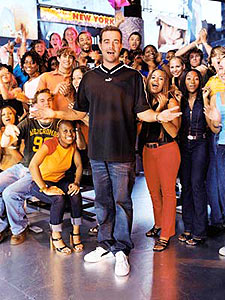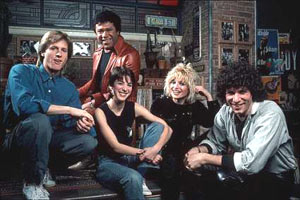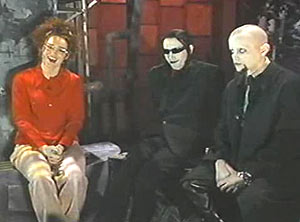I Want My MTV: A Collection Of Nostalgic Complaints
Published on November 29th, 2008 in: Issues, Music, Retrovirus, TV |By Brenna Chase
This month, Total Request Live ends its ten year run, marking the end of the oldest show still running on MTV and the end of “music” content on the channel for good. Everyone who grew up in the 90s has their memories of the viewer-controlled, top-ten-music-video-countdown, but was it ever really that great? Though the concept of TRL was geared to encourage viewers to vote like crazy to see their favorite video, it rarely showed music videos in their entirety. The show always lacked a much-needed charismatic host (did anybody ever like Carson Daly?). And while I started tuning in every day after school once the show premiered, I stopped watching years before the network (ironically) began pre-taping half of the week’s “live” episodes. I actually agree with MTV’s decision—a rare occurrence these days—to pull the show off the air. TRL sucks, and it has sucked for a long time. So why is it such a shame to see it go?

Carson Daly on the set of
Total Request Live
Photo © Erin Patrice O’Brien/Corbis
Like it or not, TRL represents the “old” MTV, the original Music Television channel. In the past ten years, the Internet has become a quick and easy source of access to any music video in existence, and as MTV’s ratings dropped, the network made drastic changes in its programming, relying on scripted “reality” soap operas to bring in young viewers. The absence of music videos has spurred nostalgic outcries from anyone who grew up with the channel. Music videos gave MTV its name and its success. They introduced both new and established artists to the mainstream, created a new art form and new celebrities, and were instrumental in changing the way we were exposed to and absorbed music forever.
But there is more to the channel than those videos. When Total Request Live goes off the air for good, I will not miss the musical content—that went out the window before the show even existed. I will miss TRL as the last of the glorious era of MTV, when programming was built around real excitement generated for and by the fans of the music, stars, and style we loved.
From its inception, MTV was the source for shows centered around the latest, hottest music and culture. The channel started out in 1981 as a consistent source of music videos with five VJs—aka “video jockeys,” the radio DJs of the new visual medium—taking turns introducing the videos from the original MTV hole-in-the-wall studio before they upgraded to Times Square. Part of the magic of many of these TRL predecessors was the spontaneity factor. There were scripts and teleprompters to read from and basic ideas to work around, but there was always room for impulsiveness (and fuck-ups).

The original VJs
However, the network gradually matured and began to create more structured, controlled shows as a supplement to the music and culture surrounding them. Shows like Headbangers Ball and Yo! MTV Raps were hosted by fresh, on-air personalities and catered towards lesser-explored genres. Artists were filmed talking and basically hanging out with the VJs in between their own videos. By the mid 80s, the channel had already become not just a source of music but a lifestyle.
This format was new to both the VJs and bands being interviewed in these early days of the channel, and it showed. Watching 30 seconds of a band interviewed by VJ Kennedy on her show Alternative Nation guaranteed discomfort. You’ve most likely blocked the icky feeling of her and various bands stuttering through incomplete phrases and attempting to fill patches of awkward silence. Search YouTube for evidence, including a clip of Rivers Cuomo responding to questions with abrupt, single word answers before Kennedy asks if she can take a sip of his Juicy Juice.
But it was so entertaining! The whole “turn on a camera and see what happens” method was intriguing to watch, as viewers were able to see their favorite artists as they really were. It’s highly doubtful they were prepped with questions beforehand and, in the early days, might not have ever seen the show before arriving at the studio. The whole tone of the show was the definition of amateur. And it was cool to see both the network and the bands figuring it out as they went along. There was nothing pre-rehearsed or fake about it.

Kennedy & Marilyn Manson on
Alternative Nation
2 Responses to “I Want My MTV: A Collection Of Nostalgic Complaints”
December 2nd, 2008 at 2:42 pm
I really loved this article. Even though I’m pretty young in the spectrum of MTV and wasn’t around for a bunch of the shows you mentioned, I really got what you meant and feel the same way about the lack of videos, and the eventual pre-tapings of TRL. Excellent article, really interesting and fun to read, and relatable even for someone who missed all of the 70s and half of the 80s!
December 4th, 2008 at 5:53 am
I am NOT young in the spectrum of MTV, as I recall it’s inception and how innovative and exciting a time it was to actually visualize what you only could hear unless you were able to get to a live perfomance. This article totally captures the recollection of that time – It was truly genuine and fun early on . . . But times change, just as radio gave way to TV, the availibilty of internet access to whatever past or current visual musical performances you’d like to see has had an impact on MTV. You don’t have to vote to see what you want to see – you just type it into your computer – TRL no longer required. It’s not as fun and doesn’t require any social interaction (not that MTV did so much but at least there was some social connection there) but it is what it is, and this article exemplifies that, as it very accurately recollects and depicts what once was.
Time limit is exhausted. Please reload the CAPTCHA.